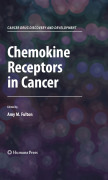
Chemokines are a superfamily of low molecular weight cytokines that were initially described based on their ability to induce the directed migration of leukocytes to sites of inflammation or injury. In humans, there are approximately45 chemokines that bind to 19 G-protein-coupled receptors. In addition to mediating cellular migration, chemokines have now been shown to affect many cellular functions including survival, adhesion, invasion, proliferation, and to regulate circulating chemokine levels. Although chemokine receptors were first described on leukocytes, it is now appreciated that chemokine receptors are also expressed by many other cells including endothelial and epithelial cells. Since the first description of chemokine receptors on malignant cells in 2001, an extensive literature has developed describing the expression and function ofchemokine receptors in many malignancies. Cumulatively, these data indicate that chemokine receptors may serve as biomarkers of tumor behavior as well as potential therapeutic targets It is an appropriate time to summarize what we doand do not know about the role of chemokine receptors in cancer behavior INDICE: Overview-Biology of Chemokine receptors.- First characterization of chemokine receptors in breast cancer.- The role of CXCR4 in ovarian cancer growth/apoptosis.- Functional Domains of CXCR4.- Function versus expression of CXCR4.- Regulation of chemokine receptor expression by Von Hippel-Lindau gene and hypoxia.-Transactivation of Her-2 receptor tyrosine kinase by CXCR4-N.- The role of CXCR3 in melanoma.- CXCR3 and breast cancer metastasis.- The role ofCCR7 in metastasis.- The CCL5/CCR5 axis in cancer.- The angiogenic chemokinesand cancer.- The role of decoy receptors in cancer behavior.
- ISBN: 978-1-60327-266-7
- Editorial: Humana
- Encuadernacion: Cartoné
- Páginas: 250
- Fecha Publicación: 01/11/2008
- Nº Volúmenes: 1
- Idioma: Inglés
